Hastings Central School has a shade house that has produced a range of seedlings which have been gifted to many planting projects over the years. It has been the touchstone for Enviroschools activities. With much of the learning happening in the classroom the shade house has been a pathway to Learning for Sustainability and creating partnerships with local iwi through a restoration project.
The school is beginning to deepen their Enviroschools Programme with engagement beyond the shade house. A reflection process for becoming a Bronze Enviroschool helped identify ways that both staff and students could become more involved, with a shift towards a place-based sustainable curriculum.
When doing a stock take of the plants in the shade house and working on the Enviroschools Whole School Vision Map the students decided that they would like to create a compass/clock to echo the Ātea a Rangi star compass (which is situated in the region) and have created an outdoor “living classroom” by planting a circle of 12 mānatu (ribbonwood) trees as pou. At the centre a nikau has been planted and that it will eventually provide a natural canopy over the area.
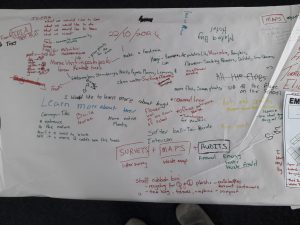
Collating ideas – wow so many things to think about!
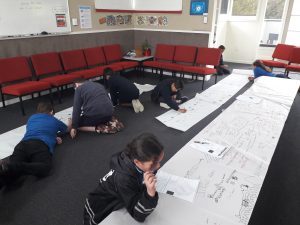
Students work on ideas for the future to create their whole school and community vision.
The students have named the area Mākirikiri in reference to the awa that once ran through the school grounds. Immediately within the Mākirikiri area are 20 year-old native trees, which gift seedlings of kōwhai, tī kōuka and mānatu to the shade house. Plants for rongoā have been planted near the community gardens.
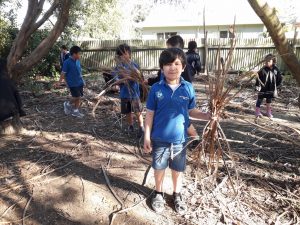
Hasting Central School community was not using the community gardens space much. This is a large fenced off area with a lot of potential. A discussion between Hastings Central School principal and the neighbouring Akina Activity Centre principal opened up an opportunity to have this area better utilised. Now Akina students have their own crop and compost systems up and running.
These students were picking up cabbage tree leaves to place around the circle of trees they had planted. They were enjoying a cultural pacific lens of keeping the space tidy and also creating and nurturing the space by laying the leaves by the young trees. They also tied some of the leaves on nearby trees to be creative and dress the space in a kaitiaki practice.
The school has begun to connect with another Enviroschool, Te Kura o Pakipaki, who are at the beginning of their haerenga. Pakipaki School initially began by giving a koha of tōtara seeds gathered from their school grounds to Hastings Central School. This led to the gifting back of young plants for the awa that runs behind the Houngarea Marae. Many students at the urban Hastings Central School whakapapa to the marae community area of Pakipaki and this connection became an important part of empowering the students through understanding their stories and cultural values. In the vision planning, students have listed that they wish to continue learning and planting for, and at the awa, visiting the marae and building relationships with the local iwi.
This process has provided opportunities for all students to tell their stories and explore their cultures. The school is supported through Te Ara Whakamana: Mana Enhancing Programme.
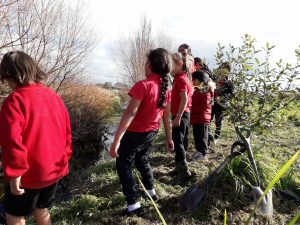
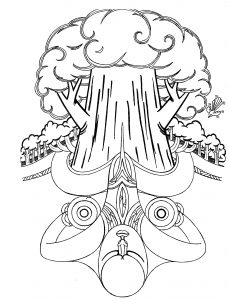
Tānemahuta: Qualities of growth, strength, shelter, diversity of life.
This is our awa, Awanui. Students from Pakipaki School mihi to their place as part of preparing for planting during Matariki of the native trees gifted by Hastings Central School.
The Hastings Central students who have been part of the journey are now working on their Enviroschools Vision. They, and the teachers, have ideas for the students to carve pou for the entrance of the nature trail. A team of teachers will plan for next year to begin weaving ideas from the vision into a sustainability curriculum. This will include connecting and collaborating with nearby Heretaunga Kindergarten Association Enviroschools to strengthen ties and raise awareness and understand of what knowledge and practices the tamariki are transitioning to schools with.
These students’ imaginations and learning were so connected and engaged when they participated in the Vision Mapping exercise. Feedback from teachers was that the support from an Enviroschools facilitator opened their eyes to new ways to learn and culturally empower students. The students thoroughly enjoyed the experiential learning, saying ‘we want to do more learning this way!’ It was such a wonderful way to begin to shape and scaffold a school-wide Sustainability Action Plan and support curriculum planning to include more Learning for Sustainability opportunities. The plan will set targets and actions and monitor the school’s progress/ journey as student action-based learning develops and partnership blossom.

Grandmother and her granddaughter – intergenerational learning and action. Here they were working on digging the hole for the plant together.
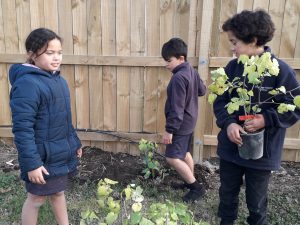
These kawakawa plants need lots of nutrients and care so that their leaves can be used to help us.
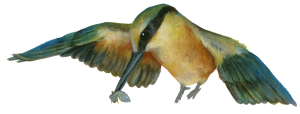
The role of the Enviroschools Facilitator in this process was to scaffold the relationship building, open up opportunities and sow seeds for possibilities. Reflective practice helps champion the progress and acknowledge the realities.
Banner Photo: Students from Hastings Central School are feeling happy about the health of their native seedlings.
